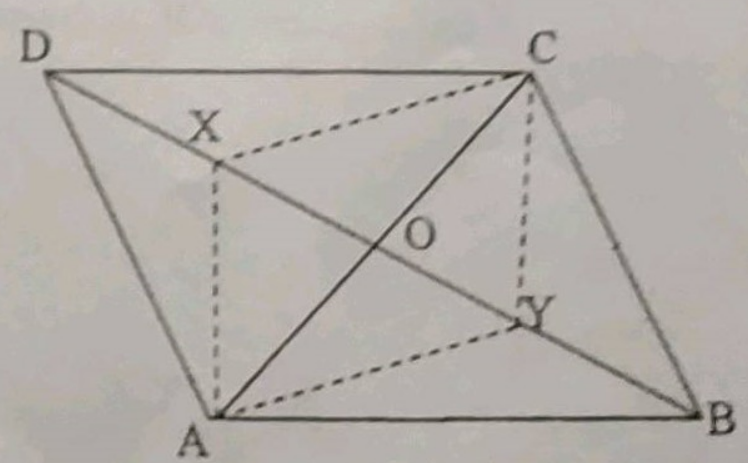A rectangle ABCD,
where A≡(0,0),B≡(4,0),C≡(4,2)D≡(0,2)
, undergoes the following transformations successively:
f1(x,y)→(y,x)
f2(x,y)→(x+3y,y)
f3(x,y)→(x−y2),x+y2)
The final figure will be
(a) square
(b) a rhombus
(c) a rectangle
(d) a parallelogramSolution in Bengali
a square
a rhombus
a rectangle
a parallelogram
The correct Answer is:D
Clearly,A will remain as (0,0),f1 will make B as (0,4) , f2 will make it (12,4) , and f3 will make it (4,8),f1 will make C as (2,4),f2 will make it (14,4) and f3 will make it (5,9). Finally, f1 will make D as (2,0) f2 will make it (2,0) and f3 will make it (1,1) so, we finally get A≡(0,0),B≡(4,8),C≡(5,9) , and D≡(1,1). Hence,
mAB=84mBC=9−85−4=1,mCD=9−15−1=84,
mAD=1,mBC=95,mCD=8−14−1=73,
Hence, the final figure will be a parallelogram.

Topper's Solved these Questions
- COORDINATE SYSYEM Book:CENGAGE PUBLICATIONChapter:COORDINATE SYSYEM Exercise:Multiple correct
Explore 13 Videos
- COORDINATE SYSYEM Book:CENGAGE PUBLICATIONChapter:COORDINATE SYSYEM Exercise:Linked
Explore 10 Videos
- COORDINATE SYSYEM Book:CENGAGE PUBLICATIONChapter:COORDINATE SYSYEM Exercise:Concept applications 1.6
Explore 9 Videos
- COORDINATE SYSTEMBook:CENGAGE PUBLICATIONChapter:COORDINATE SYSTEMExercise:Multiple Correct Answers Type
Explore 2 Videos
- CROSS PRODUCTS Book:CENGAGE PUBLICATIONChapter:CROSS PRODUCTS Exercise:DPP 2.2
Explore 13 Videos
Similar Questions
If (-6,-4), (3,5),(-2,1) are the vertices of a parallelogram, then remaining vertex cannot be
View SolutionFor points P=(x1,y1)and Q=(x2,y2) of the co-ordinate plane a new distance d(P,Q)=|x1−x2|+|y1−y2| is defined .Let O(0,0)and A(3,2). The set of points in first quadrant which are equidistant from O and A is
View SolutionFind the locus of a point whose distance from (a, 0) is equal to its distance from the y-axis.
View SolutionCoordinates of points on curve 5x2−6xy+5y2−4=0 which are nearest to origin are
View SolutionLet →a and →b be two vectors of equal magnitude 5 units. Let →p,→q be vectors such that →p=→a−→b and →q=→a+→b. If |→p×→q|=2{λ−(→a.→b)2}12, then value of λ is
View SolutionA rectangle ABCD, where A≡(0,0),B≡(4,0),C≡(4,2)D≡(0,2) , undergoes the following transformations successively: f1(x,y)−−→y,x f2(x,y)−−−−−−→x+3y,y f3(x,y)−−−−−−−→(x−y)/2,(x+y)/2) The final figure will be square (b) a rhombus a rectangle (d) a parallelogram
View SolutionIn Figure, ABCD is a parallelogram and X and Y are points on the diagonal BD such that DX=BY . Prove that AXCY is a parallelogram (ii) AX=CY, AY=CX AYB ≅CXD (iv) AXD≅ CYB

View SolutionThe value of |[a,a+d,a+2d] , [a+d,a+2d,a+3d] , [a+2d,a+3d,a+4d]|+|[b
View SolutionIdentify X and Y in the following
H2C∣Br−C∣BrH2+KOHalcohol−−−→XNaNH2−−−−→Y
View Solution1) Fragmentation () a) Planaria br 2) Unripe fruits () b) Yeast br 3) Desire () c) Spirogyra br 4) Reproduction () d) Watermelon br
View SolutionComplete the following reactions :
(i) CH3−CH2Br+KOH(aqueous)Boil−−→X+Y
(ii) CH3−CH2Br+NH3→X+Y
View SolutionIdentify the set of reagents X and Y in the following set of transformations :
CH3CH2CH2BrX−−→ProductY−−→CH3CHCH3|Br
View Solutionनिम्न अभिक्रिया में X व Y को पहचानिए:
H2C | Br− CH2∣Br+KOHऐल्कोहल−−−−→XNaNH2−−−−→Y
View SolutionCH3−CH2−CH2−BrAlc.KOH−−−−−→CH3−CH=BrHBr−−→CH3−Br∣CH−CH3
View SolutionA rectangle ABCD, where A≡(0,0),B≡(4,0),C≡(4,2)D≡(0,2) , undergoes the following transformations successively: f1(x,y)−−→y,x f2(x,y)−−−−−−→x+3y,y f3(x,y)−−−−−−−→(x−y)/2,(x+y)/2) The final figure will be square (b) a rhombus a rectangle (d) a parallelogram
View Solution